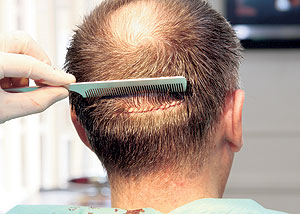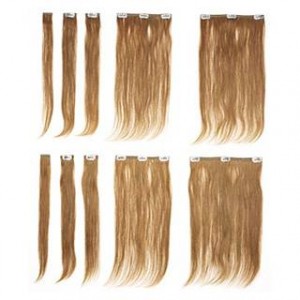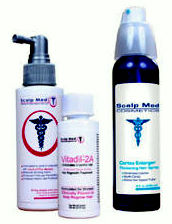Archive for November, 2009
Monday, November 30th, 2009
 Hair transplant surgery is designed to restore hair in men and women depending on the condition. For most, this is done in the event of male or female patterned hair loss. Others may use this procedure for other areas of the body that may have once had hair like the eyebrows and others to place hair like facial hair or where they may see fit. The only remaining issue is the scar that remains in the donor area after a hair transplant procedure. Hair transplant surgery is designed to restore hair in men and women depending on the condition. For most, this is done in the event of male or female patterned hair loss. Others may use this procedure for other areas of the body that may have once had hair like the eyebrows and others to place hair like facial hair or where they may see fit. The only remaining issue is the scar that remains in the donor area after a hair transplant procedure.
Can this be avoided? Is there any way to remove or conceal an existing scar?
Depending on the procedure, the scar can either be avoided or minimized. Follicular unit extraction (FUE) is an advanced hair transplant procedure where hair graft units are selectively extracted and refined without leaving a linear scar in the donor area. This technique has also been used to transplant hair into an existing hair transplant scar. This is one technique used to conceal a donor area scar but it does not remove it. The objective is to conceal the scar as much as possible.
For those patients looking into hair transplant surgery, follicular unit transplantation (FUT) is the golden standard in hair restoration. There are ways to minimize the scar’s appearance. In most cases, a hair transplant surgeon can use single or dual trichophytic closure to minimize the visibility of the scar in the donor area. This technique allows hair to grow in through the scar creating an illusion and concealing the scar. Patients whom have had a hair transplant procedure can undergo scar revision and have the existing scar excised and reclosed using this technique if it has not already been done.
As stated, the objective is to minimize the visibility of the donor scar. If the patient is undergoing hair transplant surgery through FUT, you must bear in mind that a scar will still be present. It has been noted that Botox can also be used to avoid additional stretching of the scar further preventing visibility. This should be taken care of right after a hair transplant procedure. These options should be discussed with your hair transplant surgeon to assure that you are getting exactly what you want out of your hair transplant procedure.
Tags: hair restoration scar, hair scar, hair transplant scar, how to remove hair transplant scar, remove hair restoration scar, remove hair transplant scar, remove scar
Posted in Bakersfield hair transplant, California hair transplant, hair transplant, men hair restoration, Newport Beach hair transplant, Orange County hair transplant | No Comments »
Saturday, November 28th, 2009
Q:
To Dr. Mohebi:
17 days have passed since my hair restoration procedure at your office in the San Fernando Valley. As I remember, I had an FUT procedure with bi-lateral trichophytic closure performed for about 650 grafts to reinforce my front hairline. I want to make sure to say first off that I’m extremely grateful for the time you took to answer the questions I had in a well-informed and honest manner. Also, I’d like to say I had a wonderfully positive experience and was treated kindly by everyone at your office. It was a much different experience than the first time I had a hair transplant with someone else.
Included are five photographs (recently taken) of my grafts about fourteen days after the surgery. I got rid of the scabs on the grafts and donor area. I noticed the hair grafts are now growing, and a few have fell off the scalp. I have a few inquiries.
- One snapshot reveals, at the pinnacle of the front hairline, a red circle and the particular area looks bald and bare. Do you remember planting any grafts in this part of my head. I expected this part to have hair growing on it because the front tip sticks out.
- The donor area feels sensitive and it’s still painful but also numb in other parts. I’m wondering if this is what usually happens after a fortnight.
- The back of my head (donor area) feels stretched and makes it hard for me to look at my shoes or look down when urinating. It’s a bit painful. I don’t think I had this issue after my first hair transplant. Or maybe the pain wasn’t as prolonged as it is now. Maybe it’s because the bi-lateral trichophytic closure is on another scarline? When do you think the pain in my donor site will go away?
Thanks again for the well-done procedure. I look forward to hearing back from you.
A:
It warms my heart that you enjoyed your visit with us when getting your hair transplant. You underwent a donor scar revision procedure to enhance the look of your donor linear scar on the back of your head with a two sided tricophytic closure to ensure hair growth into the scar for the highest invisibility. About your questions, I’ve written below my responses to them in chronological order.
- Intentionally, we made the frontal area irregular so it wouldn’t appear to look linear and reconstructed. After the hair transplant, you ought to have lost a good number of grafts. The way your hair looks now and is not the way it will look eventually. I’d advise you to wait at least another six or seven months so all your hair will have grown out. It will look much better.
- As part of the healing process, a bit of inflammation is normal and will appear about two weeks after a hair transplant procedure. But, if the inflammation doesn’t eventually go away or if it becomes more inflamed, come to my office immediately.
- You may feel more pain and stretching on the back of your head because you’ve had previous surgeries. There wouldn’t be as much pain in the donor site if you hadn’t ever had a hair transplant. Try not to look down too much or in a herky-jerk manner for the following eight weeks after surgery because there’s a risk of stretching out the donor scar. On the second month, if there’s still pain, visit me and we’ll take a look at it. In the meantime, if there are other questions you may have about hair growth or other inquiries regarding your hair transplant, call and make an appointment to see me.
I’m eager to meet with you again in later visits.
Tags: bilateral tricophytic closure, hair grafts, hair transplant scar, pain after hair transplant, scabs of hair transplant, tension after hair transplant, tension of donor wound, trichophytic closure, tricofitic, tricophytic closure
Posted in donor scar, hair transplant, men hair restoration, Newport Beach hair transplant, Orange County hair transplant | No Comments »
Wednesday, November 25th, 2009

US Hair Transplant, a respected leader in hair restoration surgeries, will be holding a grand opening of a new San Diego Hair Transplant Center sometime in early 2010. With hair restoration centers already well established in Encino, Beverly Hills, and Orange County (Foothill Ranch), Dr. Parsa Mohebi and his staff plan on providing their self-image enhancing services to residents of America’s Finest City.
“San Diego is like a sister city of L.A. And I know from conversations with many of our patients that there is a demand for quality hair restoration clinics in the area” said Dr. Parsa Mohebi, Medical Director, US Hair Transplant, “People want to look their best, and at the same time, have a natural-looking appearance.”
US Hair Transplant currently serves a handful of San Diego-area residents, but establishing an office in the southern most part of the Golden State would, Dr. Mohebi says, be a more convenient resource for his clients, and also convey the message that US Hair Restoration is willing to branch out to meet the growing needs of its prospective clientele.
“Hair restoration is a wonderful solution and is a way for people with hair loss to feel good about themselves again, without compromising good health,” adds Reyes Mendoza, Public Relations, US Hair Restoration.
Beginning in the early 1990s, surgical hair restoration proved to be a successful solution for men and women suffering hair loss. Since then, modern technology and dedicated study by doctors and scientists involved in the hair transplant industry have made hair restoration a safe and rewarding option for people around the world.
Currently, due to the current state of the economy, US Hair Restoration is offering 20% off its standard cost of hair transplants and 0% financing for two years on a standby basis until December 31, 2009, to achieve their its goal of being able to provide quality hair transplants, with affordable prices of hair restoration, for all people. Hotel stay is provided for one night along with transportation to and from the hotel for anyone traveling over 50 miles to a US Hair Restoration office.
Tags: California hair transplant, california hair transplant center, hair transplant, hair transplant center, la jolla hair transplant, la jolla hair transplant center, poway hair transplant, poway hair transplant center, san diego hair transplant, san diego hair transplant center
Posted in California hair transplant, hair transplant | No Comments »
Monday, November 23rd, 2009
Q:
Hello Dr. Mohebi,
It’s my sixth day after I got my hair transplant in Los Angeles and all seems to be healing and on track. The other day, when I was shampooing, I noticed some follicles. Maybe about six of them. Is this something to be concerned about?
What I’m pressing about is the staples area of my head. It doesn’t look infected or have a lot of inflammation, but it is really sensitive, meaning that I feel pain each time I hit that area of my head on something or just swipe my head past a car head cushion. Also, with not much shock, the pain level has increased as I’ve taken less anti-inflammatory drugs. Are there any over the counter pills you’d recommend. Whether topical or oral drugs, it doesn’t matter to me.
All I know is, I’m really stoked about getting these staples removed in a few months! Can’t wait until they’re off.
Thanks,
A:
Dear Joe,
After a period of time, the closed donor wound sensitivity to pain and its tenderness will decrease. But after a few days, the patient might feel some pain in the donor area while on medication. If the case happens to be that the transplant donor area is becoming more sensitive, pay me a visit and I’ll take a look at your donor area to make sure its healing properly.
Yours truly,
Tags: Anti-Inflammatory, Donor Wound, Follicles, Healing, Inflammation, Pain Killers
Posted in California hair transplant, hair transplant, men hair restoration, Orange County hair transplant | No Comments »
Thursday, November 19th, 2009

Q:
Not too long ago, I had a hair transplant (using FUE). Things were OK until several months after the transplant. I spent some time having fun in the sun, and it was maybe close to triple digit degrees outdoors. As soon as I got back to my house, I noticed my scalp in the transplanted area had turned white. It looked like the skin on my head had been scorched. But I didn’t think it was a big deal and I kept on using the Minoxidil with Betaderm spray, which my doctor highly recommended.
A few weeks later, the top of my head (which had been grafted) began to peel and the skin fell off (like a sun burn). And there were a few transplanted hairs which fell off as well, with the skin. This really alarmed me. After about eight weeks, the scalp seems to have healed, although there is some redness in places; but, overall, it seems to be OK. But, I’m a bit worried about the condition of my after-playing-in-the-sun scalp. I know it was probably a sun burn, but I just hope my grafts weren’t damaged beyond repair. I’ve done some research on skin consequences of sun burn, but I wonder if the grafts can ever fully recover from the exposure to the ultra-violet rays. I know if my skin becomes more tan, it’s OK. But about my grafts, I’m really concerned about them.
I need answers, doc.
Yours truly,
A beach bum with a hair transplant
A:
Hey beach bum,
Skin and scalp which has been exposed to the sun’s rays for long periods of time damage both native hairs and transplanted hair. The consequences can be especially harmful if a person who has had a hair transplanted is not under an umbrella or is not wearing a hat of some sort. The scalp skin could be damaged that way. It is best to stay out of the sun after a few minutes, at most. For the first six months, hair transplant patients may want to use sunscreen or wear a hat to prevent hair loss and to guard against permanent damage to hair follicles.
For those who don’t like to wear hats or other types of protective head wear ought to guard their hair as if their financial stability depended on it. Make sure your hair density increases to the point in which your hair follicles cover your entire scalp and so the scalp skin is not exposed to the sun’s scorching rays (especially during summer).
I can’t give you a verdict on whether your newly transplanted hair is permanently damaged. I’m sure I don’t have to tell you this, but I’ll say it anyway in case there are people reading this blog who are in a similar situation: from now on, be very careful about your scalp’s sun exposure. And just kick-back and wait a while to see if the damaged hair grows back.
Remember, after hair transplant care is very important, if not crucial to the longevity of your hair restoration results.
Tags: after hair transplant, complications, fue, hair loss, hair transplant surgery, men hair loss, sun exposure
Posted in Bakersfield hair transplant, California hair transplant, hair transplant, men hair restoration, Newport Beach hair transplant, Orange County hair transplant | No Comments »
Monday, November 16th, 2009

Q:
Hey Doc:
My hair is as thin as the state of economy; I’m trying to figure out how to make it stronger. Two products I tried are, Chronostin, suggested by my barber; the other one was recommended to me by my psychiatrist: it’s called Minoxidil, Estradiol Vateral, Esopropyl Acohol.
I’d like to hear your expert advice on these products, doc?
Yours truly,
A:
I commend you for seeing a skin doctor. As part of your dermatologist’s diagnosis, I’m quite certain he took a look at you to see if there was miniaturization of hair leading to hair loss in men. Let me add that combining minoxidil with other hormonal medications hasn’t been proven to be a solution to hair loss. You were probably diagnosed with male pattern baldness and then the doctor decided to recommend it. Since that’s what happened, you might also want to try finasteride, a medication much more powerful compared to Minoxidil, based on a few research publications.
The other product, Chronostim, I don’t know what that is. But, being the dedicated doctor I am, I did some of my own research on it. Chronostim is a product that says it is able to act on a group of factors playing a part in hair loss. It has both morning and nighttime treatments.
It contains sabal enriched lauric acid (seborrhea regulating ), tocopherol Nicotinate (microcirculation stimulating, oxygenating bulbar), glycyrrhetinic Acide bta (reinforces the activity of 5-alpha ductase), excipient alcohol-silicone, perfumed- hypoallergenic.
Chronostim, called NIGHT, contains a semblance of Ruscus, enriched in Neoruscine (stimulating of the VEGF), Diguanosine traphosphate (GP4G – cellular stimulant), Piroctonolamine (cleansing, anti-irritant), excipient hydro-alcoholic, perfumed-hypoallergenic.
Clear as the Los Angeles smog, right? To give it to you straight, these products haven’t been proven in any way whatsoever to aid in the treatment of men’s hair loss.
May I be so bold to say, if I were in your shoes, I’d continue taking finasteride (Propecia), if your dermatologist is okay with it. However, if you continue to experience hair loss, a hair transplant would be the best answer.
Best,
Dr. Mohebi
Tags: chronostim, Chronostin, dermatologist, estradiol vateral, finasteride, hair loss product, male pattern hair loss, minoxidil, Propeica, skin doctor
Posted in hair loss medication, hair loss products, hair transplant, men hair restoration | No Comments »
Saturday, November 14th, 2009

In the latest issue of the Journal of Internal Medicine, a new research study was published: “A Rare Complication: New Hair Growth Around Healing Wounds.” This study is related to Dr. Mohebi’s personal research at Johns Hopkins Medical Institute on gene therapy techniques and wound healing and how it affected the growth of mice hair.
The journal study was about a person who had hair growth surrounding a healing wound at Guangxi Medical University in Nanning, China.
The doctors involved in the study mention an incident in which hair growth occurred around a wound during the process of wound healing. Hair growth after wound healing is an atypical occurrence. This is the first time such an event had ever been recorded in scientific literature.
The doctors concluded that the wounds damaged the hair follicles and epidermis, but that it was possible for both to repair themselves if there was a suitable physical and chemical micro-environment. The doctors say that this new hypothesis may very well lead to new methods of managing hair loss, tissue engineering, and the regeneration of other organs.
At the laboratory of Johns Hopkins Medical Institute, and as part of my overall research, I did a major investigative study on hair growth as a byproduct of wound healing. On a few rats, after witnessing wound healing, to my delight, I found that some gene therapy techniques stimulated the hair growth.
My attention was on hair growth only and, coincidentally, our results matched other hair growth-wound healing studies, during 2005 to 2006. At the University of Pennsylvania, Dr. Cotsarelis, along with his contemporaries, first made public a study on the relationship between wound healing and hair growth through activation of the molecular pathway WNT.
Other similar studies have called attention to the fact that hair restoration through tissue engineering, hair multiplication, and gene therapy might one day happen and that we just may have a breakthrough a lot sooner than we expected all these years.
Parsa Mohebi, M.D.
Medical Director
US Hair Transplant
Tags: gene therapy, hair growth, hair loss, hair restoration, wound healing
Posted in California hair transplant, hair transplant, men hair restoration, women hair loss | No Comments »
Thursday, November 12th, 2009
 There was an article I came across about artificial hair transplantation. The practice of artificial hair or synthetic hair transplantation to treat hair loss or androgenetic alopecia has yet to be approved by the FDA. But, in other countries, artificial hair restoration is being attempted. In addition, in the Journal of Cosmetic Dermatology, there was a study published about artificial hair transplants, but the results are to be taken with a grain of salt as there weren’t a lot of participants. Nevertheless, it’s worth mentioning. There was an article I came across about artificial hair transplantation. The practice of artificial hair or synthetic hair transplantation to treat hair loss or androgenetic alopecia has yet to be approved by the FDA. But, in other countries, artificial hair restoration is being attempted. In addition, in the Journal of Cosmetic Dermatology, there was a study published about artificial hair transplants, but the results are to be taken with a grain of salt as there weren’t a lot of participants. Nevertheless, it’s worth mentioning.
Mentioned in the article were issues in the artificial hair implant process, which included: ineffective techniques, poor quality of hair fiber, and inexperienced surgeons. But, it’s important to note, the study’s aim is to convey the idea that artificial copolyamide fiber implantation seems to be relatively safe and a possible remedy to male pattern baldness or androgenetic alopecia.
The study consisted of 10 androgenetic alopecia adult test subjects who had tried more mainstream hair restoration techniques but to no avail; these test subjects agreed to have copolyamide fiber implanted on their scalps and were followed a minimum of three years. Initial implants included 100 fibers followed by subsequent sessions of up to 500 fibers per four to six weeks for the purpose of achieving a density of 20-40 fibers per cm2.
Throughout the study, during fiber implants and follow-up sessions, the researchers maintained an almost exact adherence to schedule. For the study as a whole, 10,000 fibers were implanted; for each test subject, an average of 1000 fibers. Overall (except for one person), researchers found that the implants resulted in pleasant-looking hair, didn’t have any notable side effects, and the subjects emotionally satisfied. At the entry point of most fibers, sebum deposition and temporary pitting were consistent throughout. In 30 percent of test subjects, there was a case of recurrent mild folliculitis.
In this study, common complications such as facial swelling, cellulitis, and severe scarring were not detected. It is important to note, each year, 15 percent to 30 percent of transplanted fibers fell away, which led to required regular maintenance. To conclude the study, factors of significant importance were the method of fiber transplant technique and consistent follow-up, leading to positive results. In the near future, hair transplants might be done with artificial hair for patients who don’t have quality donor hair and also are suffering from excessive baldness. But, much more testing is required to see whether artificial hair transplant can be an option for future hair loss patients.
Tags: androgenetic alopecia, artificial hair, Artificial hair implantation, cellulitis, copolyamide, FDA approval, fiber implantation, folliculitis, male pattern baldness, synthetic hair
Posted in hair transplant, men hair restoration, women hair loss | No Comments »
Tuesday, November 10th, 2009
 Q: Q:
Dear Parsa Mohebi,
I hope you’re doing great. I hope you also remember me – it’s —-. I visited your office in January in Mission Viejo, California. I am currently in Dubai! Thank you for the letter which you sent me regarding the tests I should take. I appreciate the time you took out for me. I have taken the tests and wait for the results.
I wanted to ask you a question regarding the hair growth. Recently I was going through some websites and landed on a product called ScalpMed. I was quite alarmed at how this product worked (as it says it does). I am aware that there are numerous type of products available in the market but for some reason this really got me interested. Can you please have a look at it and advice me whether or not to take it seriously?
I appreciate for your time. Looking forward to hear from you!
A:
The hair loss treatment industry is a multi-million dollar business. As such, there are usually companies offering much cheaper, short-cut type products which claim to have the same benefits as more mainstream hair restoration methods.
“I’ve tried hair loss products, but it didn’t work. I don’t think I’ll try it again.”
Most likely, that’s not a line you’ll hear in a commercial for a hair loss product on late night television. But that’s what I think of most of these infomerical-type hair loss treatment goods.
Given the high demand, hair loss products are numerous, but not always effective.
If patients ask me about hair loss products, I like to post them on this blog, as I’m sure there are a lot of people interested in reading about it. Scalp Med is a company which makes numerous products on hair thickening and hair loss treatment. Scalp Med likes to assemble different types of kits for their prospective customers, including a Detoxifying Cleanser Kit, Scalp Med for Women, and Mega-Multi Vitamins.
Like other companies in the hair loss industry, Scalp Med’s advertisements go as far as to say that they are FDA-approved. Any Joe Schmo can find photographs, legit testimonies, and other types of “proof” from balding clients who try to promote Scalp Med’s product.
There are various types of Scalp Med product, including topical Vitadil-5A for men, Vitadil-2A for women, topical NutriSol-RM, and Cortex Enlarger hair thickening spray. The first two Vitadils are topical solutions which contain minoxidil (also Rogaine’s key component). The claim Scalp Med makes is that they have formulated a unique delivery agent which is supposed to increase the absorption of minoxidil in women and men.
For the Scalp Med products NutriSol-RM and Cortex Enlarger thickening spray, we are sort of left in the dark about what exactly is contained in them. Except for minoxidil, the other ingredients contained in these products haven’t been proven to aid in the growth of hair and the health of hair. It’s important to note, the cleansing agents contained in a lot of these types of products do nothing to help a person grow their hair. No matter how clean hair is, it doesn’t help it to grow. Don’t believe the advertising.
I strongly urge you to find out whether your hair loss is treatable. It may stem from some other health condition instead of it being hereditary. If you’re a woman, and you know you have a typical type of female patterned hair baldness, then Rogaine may help.
Sincerely,
Dr. Mohebi
Tags: hair cleanser, hair loss product, hair volumizer, minoxidil, rogaine, Scalp Med, ScalpMed
Posted in California hair transplant, hair loss medication, hair loss products, men hair restoration, women hair loss | No Comments »
|
|
 Hair transplant surgery is designed to restore hair in men and women depending on the condition. For most, this is done in the event of male or female patterned hair loss. Others may use this procedure for other areas of the body that may have once had hair like the eyebrows and others to place hair like facial hair or where they may see fit. The only remaining issue is the scar that remains in the donor area after a hair transplant procedure.
Hair transplant surgery is designed to restore hair in men and women depending on the condition. For most, this is done in the event of male or female patterned hair loss. Others may use this procedure for other areas of the body that may have once had hair like the eyebrows and others to place hair like facial hair or where they may see fit. The only remaining issue is the scar that remains in the donor area after a hair transplant procedure.





